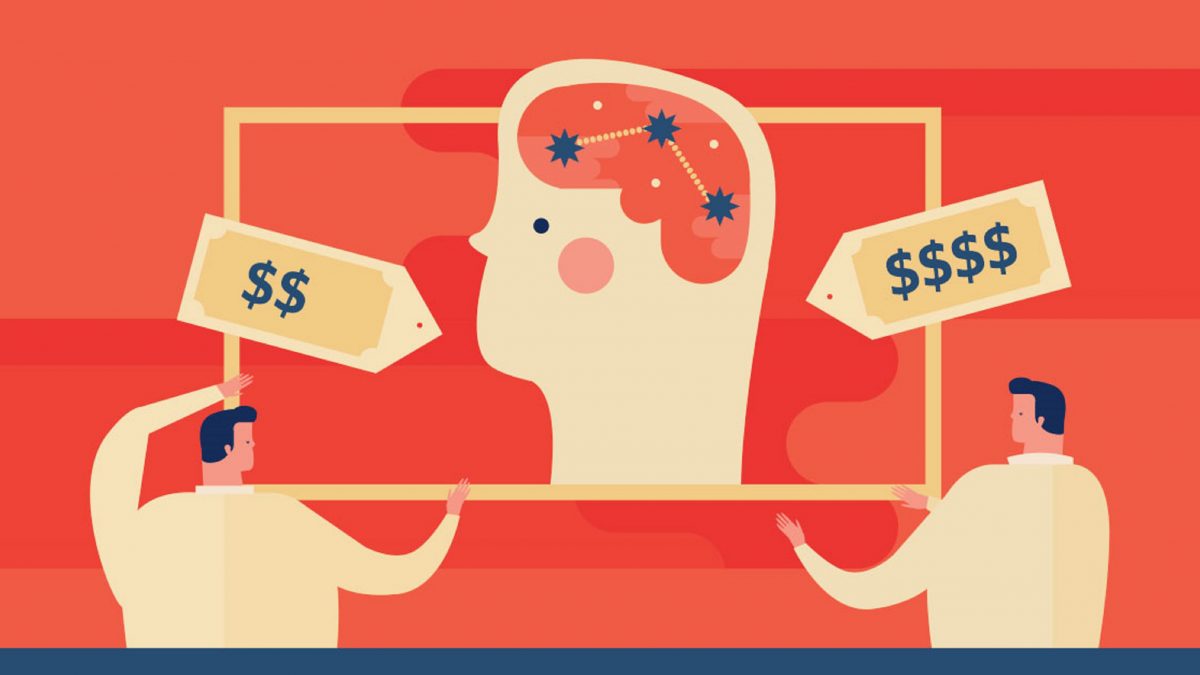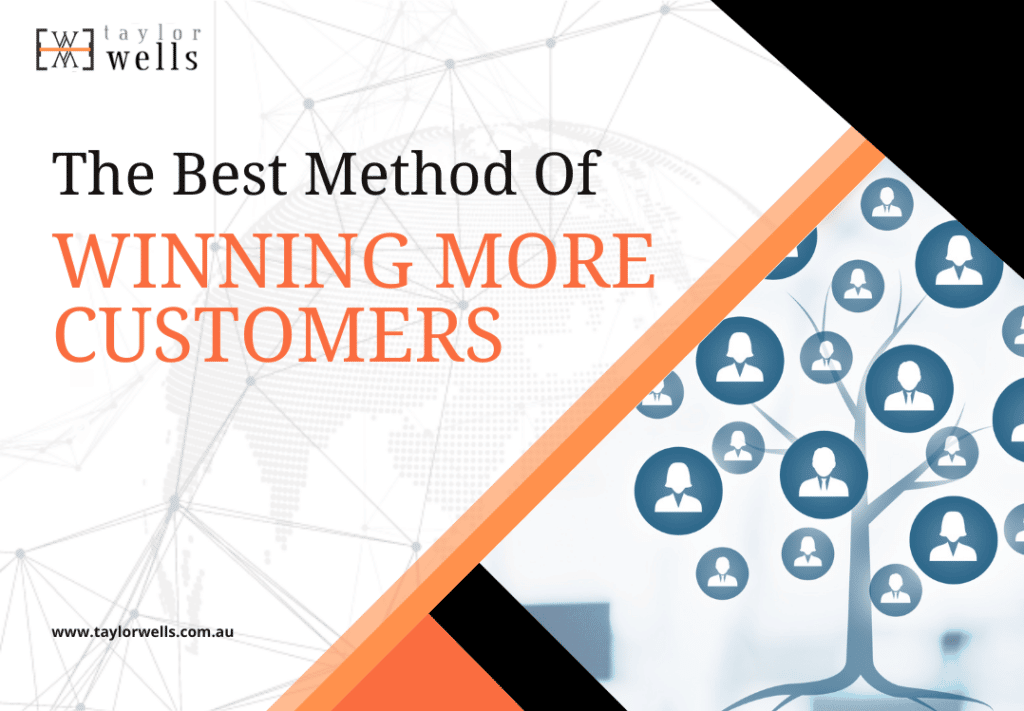
Psychological Marketing Tricks: How To Hook Customers To Different Prices 📈📉
Did you know that psychological marketing tricks like price framing massively influence how customers perceive prices?
>Download Now: Free PDF The Best Method of Winning More Customers
When we speak of price framing, we’re talking about changing the context in which a price is presented—without substantially changing the price itself—in order to encourage more purchases at more profitable price points.
Some executives find it difficult to believe that price framing actually works on customers. Many say: “Don’t we all just weigh up the pros and cons of purchase and then select the best and most logical option for us? After all, a price is a price, right?” Well, not really.
When it comes to marketing psychology, context is a massive factor influencing buying decisions. What’s more, psychological marketing tricks like price framing can and do consistently influence how we as customers perceive a price and value. This means how your customers come to know about your business as well as how they buy from you have a massive impact on their future willingness to buy or spend more with you.
In this article, we will continue to discuss the use of psychological marketing tricks in pricing. We will also share with you tips on how to use psychological marketing tricks more effectively to unlock more value for the business and your customers. In addition, we’ll demonstrate the power of price framing in a real-world example of psychological marketing tricks used by Caterpillar.
Table of Contents:
I. Psychological Marketing Tricks: How To Hook Customers To Different Prices
II. What Is Marketing Psychology and Its 6 Fundamental Principles?
Psychological Marketing Tricks: How To Hook Customers To Different Prices
Using biases in psychological marketing tricks
Psychologists discovered through controlled experiments that people use cognitive shortcuts called biases to help make choices. These are little tricks that our brain plays on us. These shortcuts don’t always produce logical decisions. We can’t fight them and we are totally helpless against them. The worst is, we don’t even know it when they gain control of our minds.
It’s called behavioural economics where the effects of psychological, cognitive, emotional, cultural and social factors on the decisions of individuals affect what they perceive. It helps explain how psychological marketing tricks and decisions are made and the change in price formula that drive public choice.
Three major principles that support behavioural economics
Psychological marketing tricks are used to stimulate customers to buy from you may it be through countdown effects, colour psychology, or discounted prices. These are clever ways to affect a consumer’s decision and can also be a good way to boost your revenue. Below are the three best psychological marketing tricks that businesses use:
1. People evaluate prices relative to a reference point
People evaluate purchases on relative terms. Looking for the value that’s reasonable. But many factors determine what is actually reasonable.
Price framing happens every day. For instance, if you were looking to buy a standard quality bread maker, you’d go online and take a look at how much they are. You’d find that a standard bread maker costs around $80. You’d then probably take a look at the higher quality bread maker to see how much more it is than the standard product. If you’re going to spend $80, you’d probably want to look at what the best in range bread maker sells for, right? You check and find it’s $40 – $120 more than the standard version.
You compare and contrast the two machines. Telling yourself you’re not an expert maker and go with the $80 one.
So, you said to yourself, “I think I’ll go to the shop and take a look at the machines” (seeing this is a novel purchase and you don’t really know what good looks like). When you get to the store, you find that you now have 3 options to choose from: You can either spend $80, $120, or $475. Rationally speaking, adding an irrelevant option should not change your decision between the $80 and the $120 ones. The pros and cons did not change; quality of the bread makers remain the same, and you’re making the same salary. You know that you’re never going to spend $475 on a bread maker.
But, the thing is, now you feel more comfortable buying the $120 one. After all, you are not buying the most expensive alternative. You’ve found the middle ground, and you’re probably happier, compared to someone who buys the cheaper version with only two options.
This is the most prominent part of the framing principle: i.e., that the attractiveness of a price will change depending on what’s presented with it. But, this is only one example of the effect one can have by introducing or removing other prices.
2. People evaluate price differences relative to the level of the initial price
The stronger a stimulus is, the more of a chance you have to make to it before we can perceive the change. The scientific name for this is the Weber-Fechner Law, is about two related hypotheses in the field of psychophysics. Both laws relate to human perception, more specifically the relationship between the actual change in a physical stimulus and the perceived change. This includes stimuli to all senses: vision, hearing, taste, touch, and smell. This is especially important when studying price elasticity. The variation in the dollar amount that people are willing to pay for the same item.
This is why you have a hard time paying $5.00 for a Starbucks Sugar-coma Mocha, but you have an easier time coming down $5,000 on the asking price for the house you’re selling.
3. Losses hurt more than gains give pleasure
Also called the Endowment Effect. People tend to ascribe more value to that which they own. Therefore, people try to avoid losses more than achieve gains. People want to avoid late fees more than they care to take advantage of early-bird discounts, even if the value is the same.
Also called the Loss Aversion Theory, people feel loss twice as much as the pleasure as to gain. Customers love discounts and hate add-on charges and fees. Even though the offering price may be the same, the route through which the price is offered affects the willingness of prospects to give payment. Discounts are perceived as a win for customers, while add-on charges are perceived as a loss.
When companies lower prices as a way of providing their customers with greater value, people think this is acceptable. However, when a company raises its prices to make an increase in their profits at the expense of their customers, people don’t like this very much – and rightly so. It’s a big and unpleasant loss.
This type of loss is the stick-slip dimension of price framing. In other words, it is when the movement of price changes influence customers’ price choices.
Are Some Price Increases Psychological Marketing Tricks?
Increasing prices is usually blamed on external factors, such as supplier costs, maintenance costs, and inflation. In an alternative approach, price rises can be positioned as being proportional, or even a relative discount, to an improvement in the underlying offering.
An example of this is the pricing in the marketing mix of Caterpillar on the basis of the technology used, product range and competition. Despite pricing much higher than other manufacturers, pricing has never been a problem for the company. Customers satisfied with the CAT (Caterpillar) products are even priced higher. That is because the company is successful in delivering much higher quality for the price tagged. The positive perception created that the company adds 20% extra value to the products it prices premium. So, though the products priced higher, the price is lesser for the high-tech quality that Caterpillar delivers and the risk the customer avoids from buying from them.
They explain to the customers how their prices take away risk – i.e., risk of product failure, risk of downtime. They explain how their higher prices will help their customer make more money by avoiding risk.
If a customer wants to explore a Cat retail store completely on their own, Cat wants them to be able to do just that.
A manufacturer makes sure that they are giving these customers options of how they want to view the machines. Be it on the website or showroom, you can find all the specs (and pricing) you need to know about those machines.
Tips to help your customers in the buying process using psychological marketing tricks
Psychological marketing tricks are a good technique to provide you with some new compelling ideas to improve your business’ sales or visibility. Below are some psychological marketing tricks that would help trigger positive emotional responses from buyers and help them in the buying process.
-
The Colour Psychology
Colour psychology is about influencing the purchase decisions of customers. Colour can have a strong effect on a consumer’s behaviour and buying decisions. Believe it or not, the colour could even be the one reason why a customer will buy from you. Thus, you should consider it when working on your website design.
For example, the purple colour. Brands like Cadbury or Hallmark use this colour. A colour believed to represent luxury, creativity, and problem-solving.
-
The Anchoring Effect
The anchoring effect is a strategy to get consumers to decide based on comparative values instead of intrinsic values.
Like for example, if you’re running a sale, you should put the old higher price next to the new lower price. Though the price is still fairly high, the previous price was anchored and customers think that they found a good deal.
-
The Scarcity effect
Simply, the supply and demand formula. The less availability or supply of a product there is, the more that the value increases, thus, leading to an increase in the demand for that particular product.
Do you remember when you were trying to book a plane ticket online and it said, ‘Only 3 seats left’? That’s scarcity. A psychological marketing trick used to put pressure on customers to buy.
-
The fear of missing out feeling
For example, a customer is thinking whether or not to buy a product on your website, and you should do something to force a bit closer to purchasing the item. One good technique is to put a countdown clock on your page so it will push customers to buy from you. Like, showing how many hours/minutes left that a customer can take advantage of next-day delivery. By using this technique, it puts this fear of missing out to the buyers if they don’t purchase in time.
-
Give customers reasons to buy from you
Provide your customers with reasons why they should buy your products. One strategy could be providing context such as positive customer feedback. Positive customer reviews provide potential customers with the assurance that others are satisfied with your products/services. And that they had a good experience with your business. Reassurance is key in influencing prospective customers to buy from you. They want to know that you’re reliable and offer a good service.
Implications
Customers seek value but also like to shed costs. In psychological marketing tricks, customers perceive an offer as providing value, their frame of reference skewed towards maximising that value.
If the offer perceived as a cost of doing business; they will seek to lower the cost and accept the minimum solution that performs its function. The specific message and approach made in marketing psychology to influence the frame of reference. For prospects towards a more positive attitude that is likely to encourage the buyer to purchase it.
The value-focused framing enables the customer to perceive the price as a small cost to pay receives the value offered.
〉〉〉 Get Your FREE Pricing Audit 〉〉〉
Conclusion
By leading with a description of the value on offer then following through with the price, marketing psychology can focus on uncovering the challenges facing different prospects. Including a value-based description of their offerings and a clear explanation from sales on how each product can help customers overcome specific challenges.
Communicating the price first then following through with a description of the value encourages customers to focus on the price. Additionally, it also makes customers seek discounts throughout the discussion.
Value focused negotiation requires all price variances associated with value variances in any price concession. It must be accompanied by the removal of value from the offering. Value negotiation improves customer profitability, as challenges shifted to the party that can better manage them.

What Is Marketing Psychology and Its 6 Fundamental Principles?
Marketing psychology is now the foundation of many successful businesses. Most leading company’s marketing departments have at this point hired, consulted, or created a team devoted to conducting marketing psychology research. But what is marketing psychology?
For example, have you ever asked yourself: Why does Apple’s marketing strategy work so well? The answer in part comes down to their approach and understanding of marketing psychology. By this we mean, Apple’s marketing team uses psychology to influence the minds and motives of their target market to ensure they gain market share and share of wallet.
Unlike many of its competitors, Apple knows what their customers want and what makes their customers feel good. In fact, they have studied their customers so well, that they know what triggers to pull to get their customers to desire their products – even when their products are substantially more expensive than their competitors.
So, how does psychology relate to marketing, then? The aim of marketing campaigns or strategies is to stimulate a customer to make a decision that will benefit a business or organisation. For instance, Apple creates glossy and elegant marketing ads that promote the convenience of their products and also shows customers how cool Apple products are.
Have you ever wished to read the minds of your customers to know what they’re thinking? Have you ever wanted to discover the best tactic to persuade customers to buy your products?
In this article, we will answer the question, “What is marketing psychology?” We will provide you with a few marketing methods that involve psychological understanding. We will also discuss how psychology is used in marketing. Lastly, we will share with you the six commonly used marketing psychology principles. By the end of this article, you’ll learn how and if psychology has the answers to what you are looking for to drive more profitable sales.
What is Marketing Psychology?
Marketing psychology integrates a scope of psychological theories to a company’s marketing, content, and sales strategy. It is also a way of observing patterns in humans and evaluating how it relates to their buying behaviours by understanding cognitive biases. As consumers, people are irrational, and decision-making is hugely influenced by these cognitive biases.
Marketing psychology will determine your competitive advantage in the market and let a company get an entire picture of the customers. Therefore, marketing psychology applies conceptual knowledge to the marketing field.
Marketing Methods that Require Psychological Understanding
Marketing teams use some of the top techniques that involve the psychology of the human mind. Below are a few methods that are commonly used in the industry:
- Marketing campaigns that appeal to emotions — The aim of these types of campaigns is to tap into the emotions of a person and encourage a customer to buy a product or service according to his/her feelings.
- Marketing strategies that provide exclusivity — These types of campaigns advertise a specific product/service as exclusive. It feeds the competitive drive of customers to have exclusive ownership of the most elite products available. People who are inspired by exclusivity are more than willing to spend the money just to feel like they are a part of the crowd.
- Using fear and doubt in marketing — These tactics are used in marketing to let customers feel fearful or worried about not buying a specific product or service. The focus is on the consequences of not buying the goods, instead of the benefits of having it.
What is marketing psychology and how is it used?
Nowadays, marketers use psychology more than ever before because there are various types of marketing strategies to make and customise. For instance, there’s a certain team of the marketing field that takes care of social media marketing. Particularly, this type of marketing depends on an understanding of human psychology and behaviour.
Marketers should know what encourages customers to get attracted to a brand within the realm of social media. Also, what will stimulate them to buy goods and services from the business. Understanding psychology, marketing trends and customer data are vital to all types of marketing strategies.
6 Commonly Used Marketing Psychology Principles
Understanding some fundamental theories of psychology can make your marketing successful because the right people are identifying with it (and probably converting on it also).
To help you convince, captivate, and convert more customers with your marketing, it’s important to discover what is marketing psychology. Let’s take a look at 6 common marketing psychology principles marketers use:
1. Reciprocity
This theory is based on the notion that if a business or a brand does something good for a customer, the latter will likely return the favour, and have greater cooperation in the future. In other words, providing added value to your new customers means you are starting a new relationship with them.
The concept of reciprocity principle is very straightforward. If a person does something for you, you basically want to do something for him in return. For example, if you’ve got yourself a mint along with your bill at a restaurant, that’s reciprocity.
When a waiter brings a check to the customer without a mint, the customer will tip the waiter accordingly (based on the perceptions of the service provided). One mint, the tip may jump up more than 3 per cent and two mints may mean increase it further to about 20%.
There are several ways of how a business can utilise reciprocity. You don’t have to be a very big and successful company to implement it. You can give away stuff like a sweatshirt, a tote bag, an exclusive e-book, a free desktop background, etc. Even simple things like a handwritten note can go a long way in demonstrating reciprocity. Remember though to offer the giveaways first before you asking for something in return.
2. Scarcity
This principle demonstrates that people put more value on the things that are difficult to obtain. In other words, the scarcer the product is, the more valuable it is. Customers get anxious that they will miss out the offer, therefore, leaving them no choice. Have you tried buying an airline ticket online and noticed a prompt that says, “Only 2 seats left for this fare” That’s scarcity theory using “limited product offering”. Seeing that there are only 2 tickets left, you’re more likely to make a quick decision in buying the ticket, compared to if were still 200+ tickets left at the promo price.
Some other ways where marketers use this concept are:
- Exclusive access – Brands can make their product offering appear exclusive and premium when it comes to upgraded memberships. Like VIP access to a special feature or service and getting access to something that isn’t available to everybody. This strategy lets customers feel as if they are in possession of something rare or scarce. Thus, giving them a feeling of being special.
- Black Friday sales – Retailers have somehow managed to build a sense of scarcity on excessively discounted, popular items, particularly during the holiday shopping season.
3. Social proof
This type of marketing psychology principle believes that humans have confidence on products when they recognise other people who can validate their value. Meaning, it is the “me too” effect.
Robert Cialdini, professor and author of Influence: The Psychology of Persuasion, says that when a person doesn’t know what to do, he/she will seek advice on what needs to be done.
Social proof marketing calls on the convincing powers of celebrities, experts, and customer feedback or reviews as a way to increase customers’ trust in the product/service.
Other types of social proofing you can use in promoting your business:
- Get a celebrity endorser. Celebrities and social media bloggers have the biggest influence because of their large social media followings. Enlist A-list celebrities for a launch, or simply gift your product to a famous media blogger, hoping your product gets featured on their social media accounts.
- Use an expert. Followers will listen to an expert’s recommendation especially if they have that specific need.
- Let users rate you. Allow customers to rate or provide a review or feedback. May it be a Google review or an excellent rating on the app store, the truth is, many potential customers use these reviews and ratings as a guide for the real performance of your company.
- Certification. Whether it’s a health rating, a TripAdvisor rating, or the popular blue tick on Instagram, official accreditation or certification is the easiest way to provide your first-time customers with a peace of mind.
4. Loss Aversion
This principle in marketing points out that people prefer to avoid losses than acquiring gains. Simply put, when a person has something, he/she does not want to lose it. Certainly, people don’t like to lose what they have already gained.
Marketing teams use loss aversion marketing regularly. Tell me, how many “last chance to take advantage of the offer” emails have you gotten in your inbox? Though loss aversion is an effective marketing strategy, if not done the right way, it can have a harmful effect. Remember that some customers might get annoyed with this style of marketing if they’re being flooded with emails.
Some ways of implementing loss aversion marketing strategies include:
- Limited resource. One way to attract customers into buying a product is to tell them of the scarcity of your item.
- Offering something free with purchase. It can be free shipping, a discount code or voucher, or free gift wrapping. The thought of losing a free gift can mostly serve as a basis in persuading your customers to buy a product.
- Trial offers. Research shows that people value the things they own more than those that they don’t. Therefore, by giving customers a sample product, they get the opportunity to own it. You are letting them feel the loss of not having ownership of that product.
5. Decoy Effect
The decoy effect is a situation where customers tend to change their preferences between two given options when provided a third option that’s asymmetrically dominated. However, when there are only two choices, customers make decisions based on their personal preferences. When presented with another strategical decoy option, customers are more likely to select the more expensive product of the two original choices.
To better understand the concept, let’s use the National Geographic experiment as an example:
National Geographic made an experiment to see how the decoy effect affects consumers’ decision to buy a large popcorn instead of a small or medium one.
First, they offered a group of customers a small bucket of popcorn for $3 and a large one for $7.
The result showed that most of the consumers opted to buy the small popcorn (due to their personal needs at that time).
Then they offered the second group three options: a small bucket of popcorn for $3, a medium bucket of popcorn for $6.5 (the decoy) and a large one for $7.
The result indicated that more consumers chose the large bucket of popcorn because they saw the value in the large popcorn for only $0.5.
The experiment revealed that the large bucket of popcorn asymmetrically dominated the medium bucket. Meaning, the decoy effect convinced customers to choose the expensive option.

6. Anchoring
Why do you think it’s hard to resist a sale at a clothing store? Oftentimes, the reason is anchoring. Customers base their decisions on the first information they get.
For example, if your favourite store normally sells jeans for $60, then you find it on sale for $30, for sure you’ll be elated. You’ll certainly think that you got a very good deal on those jeans. However, if your friend typically buys jeans priced $25, she won’t be nearly as joyful as you are.
Marketers should know the importance of anchoring especially if they are running a sale. During a sale, clearly provide the initial price of the item (“setting the anchor”). Then put the sale price right next to the item on sale. Putting the percentage that the customer saves from the item is also helpful.
It may be enticing to try and use all the marketing psychology strategies above, however, it’s best to think first about the business you are into, what best suits your existing techniques and what data says about your customer base.
Implications
- One essential part of a great marketer is understanding how and also why people think and behave the way they do. Understanding some of the basic elements of psychology and knowing how those principles affect how people think, feel, and act will enable you to better connect with people, influence their behaviour, and see better business results.
- Psychology plays an essential role in the marketing mix; therefore, marketing teams should have a firm understanding of human behaviour to be successful.
- Why does the marketing strategy work so well? Apple’s marketing team uses psychology to influence the minds and motives of their target market. They know what their customers want and what makes their customers feel good. Thus, they also know that their customers will buy their high-priced products because they know their customers feel a need to have the latest Apple products.
- Marketers need to determine the customer segment, what they want, and what encourages them to make a purchase in order to successfully do their job. Surely, it would be difficult to create captivating content marketing in the first place if you don’t know why it would be convincing to the target market.
- While marketers are certainly not psychologists, they definitely use various psychologically-based studies regarding human behaviour to effectively communicate with prospective customers and improve conversions on a daily basis.
〉〉〉 Get Your FREE Pricing Audit 〉〉〉
Conclusion
In conclusion, leveraging marketing psychology is the best way to have your brand stand out from competitors. It will also help you determine the most engaging way to interact with your customers.
Marketing psychology will give you a competitive edge in the digital market. Also, understanding consumer behaviour will allow you to get closer to your customers and give them elevated shopping experiences.
This comprehensive marketing psychology list is just the tip of the iceberg when we talk about consumer psychology and marketing. It’s up to you to look for a balance between them that enables you to keep a solid brand image. While at the same time developing products, creating experiences, and campaigns that your customers will love continuously.
Behind every great marketing strategy is a fundamental knowledge of human behaviour. Thus, understanding how people think, decide and behave will give you a big advantage.
Click here to access your free pdf guide on driving pricing strategy in your business.
For a comprehensive view and marketing research on integrating a high-performing capability team in your company,
Download a complimentary whitepaper on How To Maximise Margins.
Are you a business in need of help to align your pricing strategy, people and operations to deliver an immediate impact on profit?
If so, please call (+61) 2 9000 1115.
You can also email us at team@taylorwells.com.au if you have any further questions.
Make your pricing world-class!
Related Posts
Leave a Reply Cancel reply
Categories
- marketing strategy (26)
- Organisational Design (14)
- Podcast (114)
- Pricing Capability (87)
- Pricing Career Advice (10)
- Pricing Recruitment (19)
- Pricing Strategy (287)
- Pricing Team Skills (13)
- Pricing Teams & Culture (24)
- Pricing Transformation (47)
- Revenue Model (25)
- Sales Effectiveness (27)
- Talent Management (7)
- Technical Pricing Skills (35)








